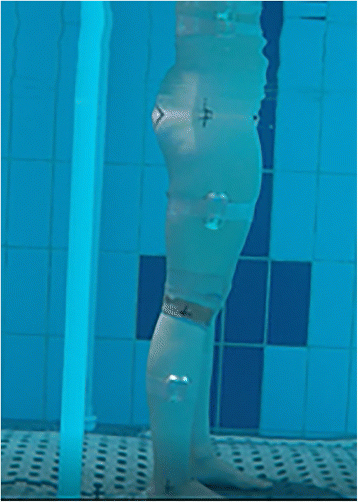Limb symmetry during double-leg squats and single-leg squats on land and in water in adults with long-standing unilateral anterior knee pain; a cross sectional study
- PMID: 29238596
- PMCID: PMC5725812
- DOI: 10.1186/s13102-017-0085-x
Limb symmetry during double-leg squats and single-leg squats on land and in water in adults with long-standing unilateral anterior knee pain; a cross sectional study
Abstract
Background: The presence of pain during movement typically results in changes in technique. However, the physical properties of water, such as flotation, means that water-based exercise may not only reduce compensatory movement patterns but also allow pain sufferers to complete exercises that they are unable to perform on land. The purpose of this study was to assess bilateral kinematics during double-leg squats and single-leg squats on land and in water in individuals with unilateral anterior knee pain. A secondary aim was to quantify bilateral asymmetry in both environments in affected and unaffected individuals using a symmetry index.
Methods: Twenty individuals with unilateral knee pain and twenty healthy, matched controls performed body weight double- and single-leg squats in both environments while inertial sensors (100 Hz) recorded trunk and lower body kinematics. Repeated-measures statistics tested for environmental effects on movement depths and peak angles within the anterior knee pain group. Differences in their inter-limb symmetry in each environments was compared to the control group using analysis of variance tests.
Results: Water immersion allowed for greater movement depths during both exercises (double-leg squat: +7 cm, p = 0.032, single-leg squat: +9 cm, p = 0.002) for the knee pain group. The double-leg squat was symmetrical on land but water immersion revealed asymmetries in the lower body frontal plane movements. The single-leg squat revealed decreased hip flexion and frontal plane shank motions on the affected limb in both environments. Water immersion also affected the degree of lower limb asymmetry in both groups, with differences also showing between groups.
Conclusions: Individuals with anterior knee pain achieved increased squat depth during both exercises whilst in water. Kinematic differences between the affected and unaffected limbs were often increased in water. Individuals with unilateral anterior knee pain appear to utilise different kinematics in the affected and unaffected limb in both environments.
Keywords: Aquatic exercise; Asymmetry; Inertial sensors; Kinematics.
Conflict of interest statement
This project was conducted in accordance to the approval by the Human Ethics Research Committee at the University of the Sunshine Coast, which approved the research protocol and data collection instruments (S/15/742). All participants signed a written informed consent prior to any data collection.A signed consent form was provided for the publication of Fig. 1.The authors declare no competing interests.Springer Nature remains neutral with regard to jurisdictional claims in published maps and institutional affiliations.
Figures
Similar articles
-
Quantifying kinematic differences between land and water during squats, split squats, and single-leg squats in a healthy population.PLoS One. 2017 Aug 2;12(8):e0182320. doi: 10.1371/journal.pone.0182320. eCollection 2017. PLoS One. 2017. PMID: 28767683 Free PMC article.
-
Differences and correlations in knee and hip mechanics during single-leg landing, single-leg squat, double-leg landing, and double-leg squat tasks.Res Sports Med. 2015;23(4):394-411. doi: 10.1080/15438627.2015.1076413. Epub 2015 Aug 14. Res Sports Med. 2015. PMID: 26275102
-
Effects of Water Immersion on Squat and Split Squat Kinematics in Older Adults.J Aging Phys Act. 2019 Jun 1;27(3):398-405. doi: 10.1123/japa.2018-0166. Epub 2019 Mar 4. J Aging Phys Act. 2019. PMID: 30300065
-
Differences in Lower Extremity and Trunk Kinematics between Single Leg Squat and Step Down Tasks.PLoS One. 2015 May 8;10(5):e0126258. doi: 10.1371/journal.pone.0126258. eCollection 2015. PLoS One. 2015. PMID: 25955321 Free PMC article.
-
Young Athletes With Quadriceps Femoris Strength Asymmetry at Return to Sport After Anterior Cruciate Ligament Reconstruction Demonstrate Asymmetric Single-Leg Drop-Landing Mechanics.Am J Sports Med. 2015 Nov;43(11):2727-37. doi: 10.1177/0363546515602016. Epub 2015 Sep 10. Am J Sports Med. 2015. PMID: 26359376
Cited by
-
The Validity of Wireless Earbud-Type Wearable Sensors for Head Angle Estimation and the Relationships of Head with Trunk, Pelvis, Hip, and Knee during Workouts.Sensors (Basel). 2022 Jan 13;22(2):597. doi: 10.3390/s22020597. Sensors (Basel). 2022. PMID: 35062562 Free PMC article.
-
Wearable technologies for monitoring aquatic exercises: A systematic review.Clin Rehabil. 2023 Jun;37(6):791-807. doi: 10.1177/02692155221141039. Epub 2022 Nov 27. Clin Rehabil. 2023. PMID: 36437591 Free PMC article.
-
The effect of increasing heel height on lower limb symmetry during the back squat in trained and novice lifters.BMC Sports Sci Med Rehabil. 2020 Jul 25;12:42. doi: 10.1186/s13102-020-00191-y. eCollection 2020. BMC Sports Sci Med Rehabil. 2020. PMID: 32728445 Free PMC article.
-
The Use of Wearable Sensors in Human Movement Analysis in Non-Swimming Aquatic Activities: A Systematic Review.Int J Environ Res Public Health. 2019 Dec 12;16(24):5067. doi: 10.3390/ijerph16245067. Int J Environ Res Public Health. 2019. PMID: 31842306 Free PMC article.
-
Effects of a corrective heel lift with an orthopaedic walking boot on joint mechanics and symmetry during gait.Gait Posture. 2019 Sep;73:233-238. doi: 10.1016/j.gaitpost.2019.07.374. Epub 2019 Jul 26. Gait Posture. 2019. PMID: 31376749 Free PMC article.
References
-
- Graci V, Salsich GB. Trunk and lower extremity segment kinematics and their relationship to pain following movement instruction during a single-leg squat in females with dynamic knee valgus and patellofemoral pain. J Sci Med Sport. 2015;18:343–347. doi: 10.1016/j.jsams.2014.04.011. - DOI - PMC - PubMed
LinkOut - more resources
Full Text Sources
Other Literature Sources


